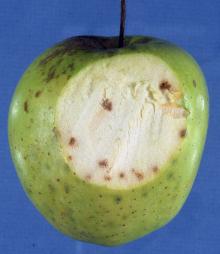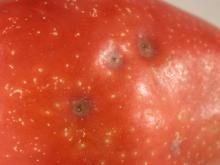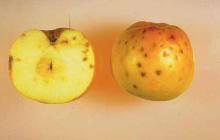See:
Apple (Malus spp.) - Storage Problems
Cause Nonparasitic. Bitter pit is a physiological disorder resulting from calcium deficiency in the fruit. It can develop within the first month or two of cold storage as well as on the tree before harvest.
Low levels of calcium in the fruit are due to competition with shoots or high fruit load for calcium, which may be aggravated by weather conditions. Hot, dry weather in July or August tends to increase the incidence of bitter pit. Irregular irrigation may also increase bitter pit, however, summer deficit irrigation reduced size and bitter pit in 'Honeycrisp'. Heavy dormant-season pruning, overthinning, and excessive nitrogen fertilizer promote bitter pit. Injury to trunks, such as winter freezes, interferes with calcium movement. Bitter pit occurs most severely in years of light crops.
Cultivars very susceptible to bitter pit: Honeycrisp, Northern Spy, Gravenstein, Grimes Golden, and Baldwin. A cultivar moderately susceptible is Golden Delicious. Cultivars that are fairly resistant are Delicious, Gala, and Winesap. Rootstock can also influence the amount of bitter pit observed on the scion.
Symptoms Circular or slightly irregular depressed spots appear on fruit surface, beneath which are brownish or streaked necrotic areas. Pitting (discrete necrotic spots) may not always be visible from the outside of the fruit. Necrotic tissue is usually soft until it dries out. Pits are more numerous on blossom end of the fruit. These may appear on the tree or in storage after harvest.
May be confused with stink bug feeding damage, which is a depressed blemish with a puncture site is always visible in the center leading to a brown cork-like area in the flesh.
Cultural control
- Prune lightly by thinning out branches rather than by heading.
- Head new shoot growth in summer on an overly vigorous tree. This may be done up until a month before harvest.
- Apply five (5) summer sprays about 1 month apart of calcium chloride or calcium nitrate at not more than 5 lb/100 gal. Add a surfactant to all sprays to reduce the possibility of burning. Higher rates will burn foliage and sometimes fruit. Sometimes calcium nitrate interferes with fruit color formation. Do not apply in hot weather. Spray must cover the fruits.
- Where possible, use overtree sprinklers to cool trees in unusually hot weather.
- Bring soil pH into optimal range of 6 to 6.5 and avoid excess nitrogen. Reduce potassium fertility by 25 to 30% for 'Honeycrisp'.
- Crop load management is important such as the use of chemical thinning to avoid alternate-year bearing. Susceptible cultivars should be managed for 5 to 7 fruit/cm2 trunk cross-sectional area in mature orchards.
- Avoid damaging trunks.
- Maintain a constant soil moisture supply during initial fruit development. Reduce irrigation 60 days after full bloom to avoid excessive fruit growth.
- To avoid the condition in stored fruit, rapidly cool fruit after harvest then store at low temperatures, high humidity and under controlled atmosphere.
- Although drenching fruit with a calcium solution after harvest can help increase calcium in the fruit, field sprays are more effective in preventing bitter pit.
- Abscisic-acid applications have been effective in increasing fruit calcium and reducing deficiency disorders
Reference Ferguson, I.B., and Watkins, C.B. 2011. Bitter pit in apple fruit. Horticultural Reviews, 11:289-355.



